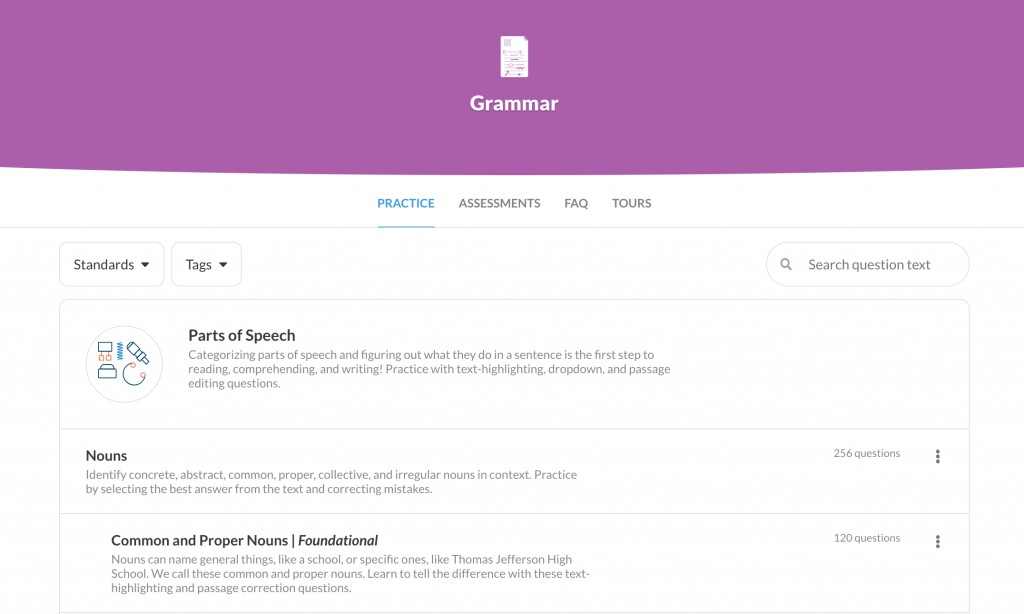Comparative and superlative adjectives are essential for expressing comparisons in English. COMPARE.EDU.VN provides a comprehensive guide to understanding and using these adjectives effectively, ensuring clear and precise communication. Master the nuances of comparison and elevate your writing with our detailed explanations and practical examples. Learn about comparative forms, superlative usages, and adjective degrees of comparison to improve your English language skills.
1. Understanding Comparative and Superlative Adjectives
Comparative and superlative adjectives are used to describe the degree of a quality. Comparatives compare two items, while superlatives compare three or more.
1.1. Defining Comparative Adjectives
Comparative adjectives are employed to highlight the differences between two nouns. They indicate which noun possesses a quality to a greater or lesser extent. Typically, comparatives are formed by adding “-er” to the adjective or using “more” before it.
For instance:
- “This car is faster than the other one.”
- “She is more intelligent than her brother.”
Comparative adjectives allow for precise comparisons, enabling you to convey nuanced differences between items or individuals. Recognizing and using them correctly enhances clarity and accuracy in communication.
1.2. Defining Superlative Adjectives
Superlative adjectives, on the other hand, are used to describe a noun that has the highest or lowest degree of a particular quality within a group. They are formed by adding “-est” to the adjective or using “most” or “least” before it.
Consider these examples:
- “He is the tallest student in the class.”
- “This is the most interesting book I have ever read.”
Superlative adjectives help to identify the extreme end of a spectrum, providing a way to express the utmost degree of a characteristic. Understanding their usage is crucial for making impactful statements and conveying exceptional qualities.
2. Forming Comparative and Superlative Adjectives
The formation of comparative and superlative adjectives depends on the number of syllables in the base adjective.
2.1. One-Syllable Adjectives
For most one-syllable adjectives, add “-er” to form the comparative and “-est” to form the superlative.
| Adjective | Comparative | Superlative |
|---|---|---|
| Tall | Taller | Tallest |
| Short | Shorter | Shortest |
| Big | Bigger | Biggest |
| Bright | Brighter | Brightest |
| Fast | Faster | Fastest |



Examples:
- “She is taller than her sister.”
- “He is the fastest runner on the team.”
It is important to note that if a one-syllable adjective ends in a consonant-vowel-consonant pattern, the final consonant is usually doubled before adding the suffix.
2.2. Two-Syllable Adjectives
Two-syllable adjectives can form the comparative and superlative in two ways: by adding “-er” and “-est,” or by using “more” and “most.” The choice often depends on the specific word and what sounds more natural.
| Adjective | Comparative | Superlative |
|---|---|---|
| Happy | Happier | Happiest |
| Simple | Simpler | Simplest |
| Gentle | Gentler/More Gentle | Gentlest/Most Gentle |
| Careful | More Careful | Most Careful |
| Anxious | More Anxious | Most Anxious |
Examples:
- “She is happier today than she was yesterday.”
- “This is the most careful work he has ever done.”
In general, adjectives ending in “-y,” “-ow,” “-er,” or “-le” tend to use “-er” and “-est,” while others typically use “more” and “most.” However, there can be exceptions, so it’s helpful to listen for what sounds best.
2.3. Three or More Syllable Adjectives
For adjectives with three or more syllables, use “more” to form the comparative and “most” to form the superlative.
| Adjective | Comparative | Superlative |
|---|---|---|
| Beautiful | More Beautiful | Most Beautiful |
| Intelligent | More Intelligent | Most Intelligent |
| Expensive | More Expensive | Most Expensive |
| Difficult | More Difficult | Most Difficult |
| Interesting | More Interesting | Most Interesting |
Examples:
- “This painting is more beautiful than that one.”
- “She is the most intelligent student in the class.”
This rule is relatively straightforward and applies consistently across all longer adjectives.
3. Irregular Adjectives
Some adjectives have irregular forms for the comparative and superlative degrees. These must be memorized.
| Adjective | Comparative | Superlative |
|---|---|---|
| Good | Better | Best |
| Bad | Worse | Worst |
| Far | Further/Farther | Furthest/Farthest |
| Little | Less | Least |
| Much/Many | More | Most |
Examples:
- “This is a better option than that one.”
- “She is the best player on the team.”
These irregular forms are commonly used, so familiarity with them is essential for accurate and effective communication.
3.1. Special Cases and Exceptions
Certain adjectives have unique rules or exceptions in their comparative and superlative forms. Understanding these nuances can significantly improve the accuracy of your writing and speech.
For example, the word “far” has two comparative and superlative forms depending on the context:
- Farther/Farthest: Used for physical distance.
- “I can run farther than you.”
- “That is the farthest I’ve ever run.”
- Further/Furthest: Used for abstract or metaphorical distance.
- “Let’s discuss this further.”
- “That is the furthest thing from my mind.”
Another special case is the adjective “old,” which can form comparatives and superlatives as “older/oldest” or “elder/eldest.” The latter is typically used for family relationships:
- “My elder brother is a doctor.”
- “She is the eldest of five siblings.”
Recognizing these specific instances ensures precise and appropriate language use.
4. Using Comparative and Superlative Adjectives in Sentences
Context and clarity are key when using comparative and superlative adjectives in sentences.
4.1. Correct Placement and Agreement
Ensure that the comparative or superlative adjective is placed correctly in the sentence to avoid confusion. It should be close to the noun it modifies. Also, ensure agreement in number and gender where applicable.
Examples:
- Correct: “She is the most diligent student in the class.”
- Incorrect: “She is the student in the class most diligent.”
4.2. Avoiding Double Comparatives and Superlatives
Avoid using both “more” and “-er” or “most” and “-est” together. This is a common error that can make your writing sound awkward.
-
Incorrect: “This is the most tallest building.”
-
Correct: “This is the tallest building.”
-
Incorrect: “He is more smarter than his brother.”
-
Correct: “He is smarter than his brother.”
4.3. Using “Than” with Comparatives
When using comparative adjectives, always include the word “than” to clearly indicate what is being compared.
- Correct: “This book is more interesting than that one.”
- Incorrect: “This book is more interesting.”
4.4. Using “The” with Superlatives
Superlative adjectives are typically preceded by the word “the” to indicate that the noun is in a class of its own.
- Correct: “She is the best singer in the choir.”
- Incorrect: “She is best singer in the choir.”
5. Common Mistakes to Avoid
Being aware of common errors helps in using comparative and superlative adjectives correctly.
5.1. Misusing “Good” and “Well”
“Good” is an adjective, while “well” is an adverb. Use “good” to describe a noun and “well” to describe an action.
-
Incorrect: “She sings good.”
-
Correct: “She sings well.”
-
Incorrect: “She is well at playing the piano.”
-
Correct: “She is good at playing the piano.”
The comparative and superlative forms are:
- Good – Better – Best
- Well – Better – Best
5.2. Incorrectly Using “Less” and “Fewer”
Use “less” for uncountable nouns and “fewer” for countable nouns.
-
Incorrect: “There are less students in this class than last year.”
-
Correct: “There are fewer students in this class than last year.”
-
Incorrect: “I have fewer water than you.”
-
Correct: “I have less water than you.”
5.3. Confusing Comparatives and Superlatives
Ensure you use the correct form based on whether you are comparing two items (comparative) or three or more (superlative).
-
Incorrect: “She is the taller of the two sisters.”
-
Correct: “She is the taller of the two sisters.”
-
Incorrect: “She is the tallest of the two sisters.”
-
Correct: “She is the taller of the two sisters.”
5.4. Using Incorrect Forms of Irregular Adjectives
Memorize the irregular forms to avoid mistakes.
-
Incorrect: “This is the goodest cake I’ve ever eaten.”
-
Correct: “This is the best cake I’ve ever eaten.”
-
Incorrect: “He is badder at math than I am.”
-
Correct: “He is worse at math than I am.”
6. Advanced Usage and Nuances
Mastering the subtleties of comparative and superlative adjectives can refine your language skills.
6.1. Intensifying Comparisons
Use adverbs like “much,” “far,” “a lot,” or “slightly” to intensify or soften comparisons.
- “She is much taller than her mother.”
- “This car is slightly more expensive than the other one.”
- “The movie was far more interesting than I expected.”
6.2. Using Double Comparatives
Double comparatives express parallel increase or decrease.
- “The more you practice, the better you become.”
- “The older I get, the wiser I become.”
- “The more you study, the less you worry.”
6.3. Expressing Equality
Use “as…as” to show that two things are equal in some way.
- “She is as tall as her brother.”
- “This book is as interesting as the last one.”
- “He is as smart as she is.”
6.4. Using “The Least” for Superlatives
“The least” can be used to form superlatives that indicate the lowest degree of a quality.
- “This is the least expensive option.”
- “He is the least qualified candidate.”
- “That was the least interesting part of the movie.”
7. Practice Exercises
Test your understanding with these exercises.
7.1. Fill in the Blanks
Complete the following sentences with the correct form of the adjective in parentheses.
- This is the ____ (good) movie I have ever seen.
- She is ____ (tall) than her sister.
- Math is ____ (difficult) than English.
- He is the ____ (intelligent) student in the class.
- This car is ____ (expensive) than that one.
Answers:
- best
- taller
- more difficult
- most intelligent
- more expensive
7.2. Identify the Error
Identify and correct the errors in the following sentences.
- She is more taller than her brother.
- This is the most tallest building in the city.
- I have less apples than you.
- He sings good.
- This book is interesting than that one.
Answers:
- Incorrect: She is more taller than her brother. Correct: She is taller than her brother.
- Incorrect: This is the most tallest building in the city. Correct: This is the tallest building in the city.
- Incorrect: I have less apples than you. Correct: I have fewer apples than you.
- Incorrect: He sings good. Correct: He sings well.
- Incorrect: This book is interesting than that one. Correct: This book is more interesting than that one.
8. Real-World Applications
Understanding comparatives and superlatives is useful in everyday life.
8.1. Professional Writing
In professional settings, using correct comparative and superlative forms can make your writing more precise and persuasive. Whether you’re drafting a report, writing a proposal, or crafting a presentation, accuracy in language enhances your credibility and impact. For example, when comparing different strategies, using phrases like “more effective” or “least risky” can clearly communicate your recommendations and justify your decisions.
8.2. Academic Writing
In academic writing, precision is paramount. Using comparatives and superlatives correctly ensures that your arguments are well-supported and clearly articulated. When comparing different theories, methods, or results, phrases such as “more significant,” “less reliable,” or “most influential” are essential for conveying your analysis accurately and effectively. Proper usage demonstrates a strong command of the English language and strengthens the validity of your research.
8.3. Everyday Communication
In everyday conversation, using comparative and superlative adjectives can help you express your thoughts and opinions more clearly and effectively. Whether you’re describing your favorite restaurant (“This is the best pizza place in town”) or comparing two products (“This phone is more advanced than the other one”), knowing how to use these adjectives enhances your ability to communicate nuanced information. This skill is particularly useful when making recommendations, expressing preferences, or providing feedback.
9. Conclusion
Mastering comparative and superlative adjectives is crucial for clear and effective communication. By understanding the rules and avoiding common mistakes, you can express your ideas with precision and confidence. Visit COMPARE.EDU.VN for more resources and practice exercises to enhance your English language skills. Whether for professional, academic, or everyday use, the ability to make accurate comparisons and highlight exceptional qualities will undoubtedly enrich your communication.
10. COMPARE.EDU.VN: Your Partner in Language Learning
At COMPARE.EDU.VN, we understand the challenges of mastering English grammar. That’s why we offer comprehensive resources to help you improve your skills. From detailed guides on comparative and superlative adjectives to practical exercises and real-world examples, we provide the tools you need to succeed.
10.1. Why Choose COMPARE.EDU.VN?
- Comprehensive Guides: Our guides cover a wide range of grammar topics, providing in-depth explanations and practical examples.
- Interactive Exercises: Test your knowledge with our interactive exercises and quizzes.
- Real-World Examples: Learn how to apply grammar rules in everyday situations.
- Expert Support: Get answers to your questions from our team of experienced educators.
10.2. Explore Our Resources
Visit COMPARE.EDU.VN to explore our resources and start your journey to language mastery. Whether you’re a student, a professional, or simply someone who wants to improve their English skills, we have something for you.
10.3. Contact Us
Have questions or need assistance? Contact us today!
- Address: 333 Comparison Plaza, Choice City, CA 90210, United States
- WhatsApp: +1 (626) 555-9090
- Website: COMPARE.EDU.VN
11. FAQs on Comparative and Superlative Adjectives
11.1. What is a comparative adjective?
A comparative adjective is used to compare two nouns, indicating which has a quality to a greater or lesser extent. It is typically formed by adding “-er” to the adjective or using “more” before it.
11.2. What is a superlative adjective?
A superlative adjective is used to describe a noun that has the highest or lowest degree of a particular quality within a group of three or more. It is formed by adding “-est” to the adjective or using “most” or “least” before it.
11.3. How do I form comparative and superlative adjectives?
The formation depends on the number of syllables in the base adjective. One-syllable adjectives usually add “-er” and “-est.” Two-syllable adjectives can use “-er” and “-est” or “more” and “most.” Three or more syllable adjectives use “more” and “most.”
11.4. What are irregular adjectives?
Irregular adjectives have unique comparative and superlative forms that must be memorized. Examples include “good” (better, best), “bad” (worse, worst), and “far” (farther/further, farthest/furthest).
11.5. What is a double comparative or superlative?
A double comparative or superlative is the incorrect use of both “more” and “-er” or “most” and “-est” together. Avoid this error by using only one form.
11.6. How do I use “than” with comparatives?
Always include the word “than” when using comparative adjectives to clearly indicate what is being compared.
11.7. How do I use “the” with superlatives?
Superlative adjectives are typically preceded by the word “the” to indicate that the noun is in a class of its own.
11.8. What is the difference between “less” and “fewer”?
Use “less” for uncountable nouns and “fewer” for countable nouns.
11.9. Can you give examples of intensifying comparisons?
Use adverbs like “much,” “far,” “a lot,” or “slightly” to intensify or soften comparisons. For example, “She is much taller than her mother.”
11.10. What are double comparatives used for?
Double comparatives express parallel increase or decrease, such as “The more you practice, the better you become.”
Are you ready to improve your English grammar and make more informed decisions? Visit COMPARE.EDU.VN today to explore our comprehensive resources and discover how we can help you compare your options and make the best choices. Contact us at 333 Comparison Plaza, Choice City, CA 90210, United States, or WhatsApp us at +1 (626) 555-9090. Don’t wait – start comparing now at compare.edu.vn.

